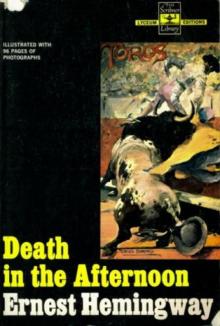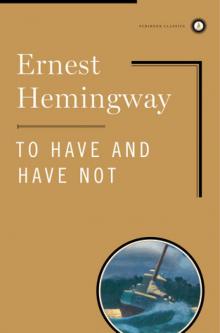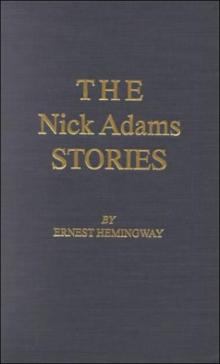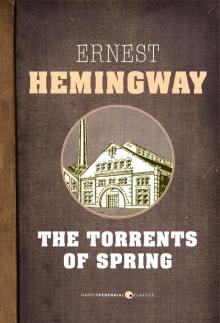- Home
- Ernest Hemingway
Islands in the Stream
Islands in the Stream Read online
Hemingway’s
“Big Book About the Sea”
ISLANDS IN
THE STREAM
With a variety of themes and moods, dynamic action scenes and—unexpectedly—a rich and ribald sense of humor, ISLANDS IN THE STREAM tells a story closely resembling Hemingway’s life.
Thomas Hudson is “a good painter.” His solitary life of artistic self-discipline on the lush Caribbean island of Bimini is interrupted by a visit from his three lively sons. In a thrilling descriptive scene, David, the middle boy, shows his courage when attacked by a shark and his endurance while fighting a thousand-pound swordfish. It is an initiation into manhood.
Years later, Hudson is in Cuba mourning the death of his oldest son. A chance encounter with his first wife renews their passionate commitment to each other.
In the final episode, a masterpiece of action and adventure, Hudson captains an improvised Q-boat hunting down the survivors of a German submarine. This assignment requires a kind of discipline wholly different from his creative life as a painter—but no less important to his integrity. It is Thomas Hudson’s most important battle.
“I don’t have to be proud of it. I only have to do it well.—Thomas Hudson
ISLANDS IN THE STREAM
“A complete, well-rounded novel, a contender with his very best ... It is 100-proof Old Ernest!”
—The New York Times Book Review
“There are brilliant descriptions in the famous Hemingway style ... When he describes the close bonds of love and hate between a group of men who are engaged in a tight and dangerous adventure with death as the ultimate stake, he remains unbeatable in his craft.”
—Maxwell Geismar, Chicago Sun-Times Showcase
“Remarkably alive with voice and muscle ... Hemingway never displayed a brawnier wit ... There are memories of Paris as pungent and vivid as anything in A Moveable Feast. And the fishing episode ... is only slightly less dazzling than Santiago’s struggle in The Old Man and the Sea.”—Charles Lee, Philadelphia Bulletin
“Incredibly moving and powerful.”
—Robert Kirsch. Los Angeles Times Calendar
“This book contains some of the best of Hemingway’s descriptions of nature: the waves breaking white and green on the reef off the coast of Cuba; the beauty of the morning on the deep water; the hermit crabs and land crabs and ghost crabs; a big barracuda stalking mullet; a heron flying with his white wings over the green water; the ibis and flamingoes and spoonbills, the last of these beautiful with the sharp rose of their color; the mosquitoes in clouds from the marshes; the water that curled and blew under the lash of the wind; the sculpture that the wind and sand had made of a piece of driftwood, gray and sanded and embedded in white, floury sand.”
—Edmund Wilson, The New Yorker
“Many of the episodes contain the most exciting and effective writing Hemingway has ever done.”
—John W. Aldridge, Saturday Review
“Marvelously alive, moving quickly and showing glimmers of joy and humor that you might never have noticed in his work before.”
—Bruce Cook, National Observer
“A part of American literary history, and his fans must read it, as they read all the rest with varying degrees of emotion, exhilaration and just plain joy.”
—William Hogan, San Francisco Examiner & Chronicle
“An immensely touching book.”
—Hal Burton, Newsday
“I fell in love with the book at first sight ... caught up by the Hemingway voice (never truer nor more relaxed) ... A lovely, loving work, deeply sad and deeply felt.”
—Mary Ellin Barrett, Cosmopolitan
“As haunting as any fiction that Hemingway ever wrote.”
—Nicholas Joost, St Louis Globe-Democrat
“The work of an estimable writer ... Hemingway’s voice is still effective, hauntingly so.”
—Bernard Oldsey, The Nation
Books by Ernest Hemingway
ACROSS THE RIVER AND INTO THE TREES
*BY-LINE: ERNEST HEMINGWAY
DEATH IN THE AFTERNOON
A FAREWELL TO ARMS
*THE FIFTH COLUMN AND FOUR UNPUBLISHED
STORIES OF THE SPANISH CIVIL WAR
FOR WHOM THE BELL TOLLS
THE GREEN HILLS OF AFRICA
THE HEMINGWAY READER
IN OUR TIME
*ISLANDS IN THE STREAM
MEN AT WAR
MEN WITHOUT WOMEN
*A MOVEABLE FEAST
THE OLD MAN AND THE SEA
THE SHORT STORIES OF ERNEST HEMINGWAY
THE SNOWS OF KILIMANJARO AND OTHER STORIES
THE SUN ALSO RISES
TO HAVE AND HAVE NOT
THE TORRENTS OF SPRING
WINNER TAKE NOTHING
*Published by Bantam Books
ISLANDS
IN THE
STREAM
ERNEST HEMINGWAY
A NATIONAL GENERAL COMPANY
This low-priced Bantam Book
has been completely reset in a type face
designed for easy reading, and was printed
from new plates. It contains the complete
text of the original hard-cover edition.
NOT ONE WORD HAS BEEN OMITTED.
ISLANDS IN THE STREAM
A Bantam Book / published by arrangement with
Charles Scribner’s Sons
PRINTING HISTORY
Scribner’s edition published October 1970
2nd printing ..... October 1970
Book-of-the-Month Club edition published October 1970
Bantam edition published February 1972
Excerpts appeared in ESQUIRE September 1970
Map by Samuel H. Bryant
Copyright © 1970 by Charles Scribner’s Sons
All rights reserved.
Copyright © 1970 by Mary Hemingway.
This book may not be reproduced in whole or in part, by
mimeograph or any other means, without permission.
For information address: Charles Scribner’s Sons,
597 Fifth Avenue, New York, N.Y. 10017.
Published simultaneously in the united States and Canada
Bantam Books are published by Bantam Books, Inc., a National General company. Its trade-mark, consisting of the words “Bantam Books” and the portrayal of a bantam, Is registered in the United States Patent Office and in other countries. Marca Registrada. Bantam Books, Inc., 666 Fifth Avenue, New York, N.Y. 10019.
PRINTED IN THE UNITED STATES OF AMERICA
Note
Charles Scribner, Jr. and I worked together preparing this book for publication from Ernest’s original manuscript. Beyond the routine chores of correcting spelling and punctuation, we made some cuts in the manuscript, I feeling that Ernest would surely have made them himself. The book is all Ernest’s. We have added nothing to it.
MARY HEMINGWAY
Contents
Note
Contents
Part I
BIMINI
I
II
III
IV
V
VI
VII
VIII
IX
X
XI
XII
XIII
XIV
XV
Part II
CUBA
Part III
AT SEA
I
II
III
IV
V
VI
VII
VIII
IX
X
XI
XII
XIII
XIV
XV
XVI
XVII
XVIII
XIX
XX
XXI
Part I
BIMINI
I
The house was built on the highest part of the narrow tongue of land between the harbor and the open sea. It had lasted through three hurricanes and it was built solid as a ship. It was shaded by tall coconut palms that were bent by the trade wind and on the ocean side you could walk out of the door and down the bluff across the white sand and into the Gulf Stream. The water of the Stream was usually a dark blue when you looked out at it when there was no wind. But when you walked out into it there was just the green light of the water over that floury white sand and you could see the shadow of any big fish a long time before he could ever come in close to the beach.
It was a safe and fine place to bathe in the day but it was no place to swim at night. At night the sharks came in close to the beach, hunting in the edge of the Stream and from the upper porch of the house on quiet nights you could hear the splashing of the fish they hunted and if you went down to the beach you could see the phosphorescent wakes they made in the water. At night the sharks had no fear and everything else feared them. But in the day they stayed out away from the clear white sand and if they did come in you could see their shadows a long way away.
A man named Thomas Hudson, who was a good painter, lived there in that house and worked there and on the island the greater part of the year. After one has lived in those latitudes long enough the changes of the seasons become as important there as anywhere else and Thomas Hudson, who loved the island, did not want to miss any spring, nor summer, nor any fall or winter.
Sometimes the summers were too hot when the wind dropped in August or when the trade winds sometimes failed in June and July. Hurricanes, too, might come in September and October and even in early November and there could be freak tropical storms any time from June on. But the true hurricane months have fine weather when there are no storms.
Thomas Hudson had studied tropical storms for many years and he could tell from the sky when there was a tropical disturbance long before his barometer showed its presence. He knew how to plot storms and the precautions that should be taken against them. He knew too what it was to live through a hurricane with the other people of the island and the bond that the hurricane made between all people who had been through it. He also knew that hurricanes could be so bad that nothing could live through them. He always thought, though, that if there was ever one that bad he would like to be there for it and go with the house if she went.
The house felt almost as much like a ship as a house. Placed there to ride out storms, it was built into the island as though it were a part of it; but you saw the sea from all the windows and there was good cross ventilation so that you slept cool on the hottest nights. The house was painted white to be cool in the summer and it could be seen from a long way out in the Gulf Stream. It was the highest thing on the island except for the long planting of tall casuarina trees that were the first thing you saw as you raised the island out of the sea. Soon after you saw the dark blur of casuarina trees above the line of the sea, you would see the white bulk of the house. Then, as you came closer, you raised the whole length of the island with the coconut palms, the clapboarded houses, the white line of the beach, and the green of the South Island stretching beyond it. Thomas Hudson never saw the house, there on that island, but that the sight of her made him happy. He always thought of the house as her exactly as he would have thought of a ship. In the winter, when the northers blew and it was really cold, the house was warm and comfortable because it had the only fireplace on the island. It was a big open fireplace and Thomas Hudson burned driftwood in it.
He had a big pile of driftwood stacked against the south wall of the house. It was whitened by the sun and sand-scoured by the wind and he would become fond of different pieces so that he would hate to burn them. But there was always more driftwood along the beach after the big storms and he found it was fun to burn even the pieces he was fond of. He knew the sea would sculpt more, and on a cold night he would sit in the big chair in front of the fire, reading by the lamp that stood on the heavy plank table and look up while he was reading to hear the northwester blowing outside and the crashing of the surf and watch the great, bleached pieces of driftwood burning.
Sometimes he would put the lamp out and lie on the rug on the floor and watch the edges of color that the sea salt and the sand in the wood made in the flame as they burned. On the floor his eyes were even with the line of the burning wood and he could see the line of the flame when it left the wood and it made him both sad and happy. All wood that burned affected him in this way. But burning driftwood did something to him that he could not define. He thought that it was probably wrong to burn it when he was so fond of it; but he felt no guilt about it.
As he lay on the floor he felt under the wind although, really, the wind whipped at the lower corners of the house and at the lowest grass on the island and into the roots of the sea grass and the cockleburs and into the sand itself. On the floor he could feel the pounding of the surf the way he remembered feeling the firing of heavy guns when he had lain on the earth close by some battery a long time ago when he had been a boy.
The fireplace was a great thing in winter and through all the other months he looked at it with affection and thought how it would be when winter came again. Winter was the best of all seasons on the island and he looked forward to it through all the rest of the year.
II
Winter was over and spring was nearly gone when Thomas Hudson’s boys came to the island that year. It had been arranged for the three of them to meet in New York to come down together on the train and then fly over from the Mainland. There had been the usual difficulties with the mother of two of the boys. She had planned a European trip saying nothing, of course, to the boys’ father when she planned it, and she wanted the boys for the summer. He could have them for the Christmas holidays; after Christmas of course. Christmas itself would be spent with her.
Thomas Hudson was familiar with the pattern by now and finally there was the usual compromise. The two younger boys would come to the island to visit their father for five weeks and then leave to sail from New York, student class, on a French Line boat to join their mother in Paris where she would have bought a few necessary clothes. They would be in the charge of their older brother, young Tom, on the trip. Young Tom would then join his mother, who was making a picture in the south of France.
Young Tom’s mother had not asked for him and would have liked him to be at the island with his father. But she would love to see him and it was a fair compromise with the unmalleable decision of the other boys’ mother. She was a delightful and charming woman who had never altered a plan that she had made in her life. Her plans were always made in secret, like those of a good general, and they were as rigidly enforced. A compromise might be effected. But never a basic change in a plan whether that plan was conceived in a sleepless night or on an angry morning or on a gin-aided evening.
A plan was a plan and a decision was truly a decision and knowing all this and having been well educated in the usages of divorce, Thomas Hudson was happy that a compromise had been made and that the children were coming for five weeks. If five weeks is what we get, he thought, that is what we draw. Five weeks is a good long time to be with people that you love and would wish to be with always. But why did I ever leave Tom’s mother in the first place? You’d better not think about that, he told himself. That is one thing you had better not think about. And these are fine children that you got from the other one. Very strange and very complicated and you know how many of their good qualities come from her. She is a fine woman and you never should have left her either. Then he said to himself, Yes. I had to.
But he did not worry much about any of it. He had long ago ceased to worry and he had exorcised guilt with work insofar as he could, and all he cared about now was that the boys were coming over and
that they should have a good summer. Then he would go back to work.
He had been able to replace almost everything except the children with work and the steady normal working life he had built on the island. He believed he had made something there that would last and that would hold him. Now when he was lonesome for Paris he would remember Paris instead of going there. He did the same thing with all of Europe and much of Asia and of Africa.
He remembered what Renoir had said when they told him that Gauguin had gone to Tahiti to paint. “Why does he have to spend so much money to go so far away to paint when one paints so well here at the Batignolles?” It was better in French, “quand on peint si bien aux Batignolles,” and Thomas Hudson thought of the island as his quartier and he was settled in it and knew his neighbors and worked as hard as he had ever worked in Paris when young Tom had been a baby.
Sometimes he would leave the island to fish off Cuba or to go to the mountains in the fall. But he had rented the ranch that he owned in Montana because the best time out there was the summer and the fall and now the boys always had to go to school in the fall.
He had to go to New York occasionally to see his dealer. But more often now his dealer came down to see him and took canvases north with him. He was well established as a painter and he was respected both in Europe and in his own country. He had a regular income from oil leases on land his grandfather had owned. It had been grazing land and when it was sold the mineral rights had been retained. About half of this income went into alimony and the balance provided him with security so that he could paint exactly as he wanted to with no commercial pressure. It also enabled him to live where he wished and to travel when he cared to.
He had been successful in almost every way except in his married life, although he had never cared, truly, about success. What he cared about was painting and his children and he was still in love with the first woman he had been in love with. He had loved many women since and sometimes someone would come to stay on the island. He needed to see women and they were welcome for a while. He liked having them there, sometimes for quite a long time. But in the end he was always glad when they were gone, even when he was very fond of them. He had trained himself not to quarrel with women anymore and he had learned how not to get married. These two things had been nearly as difficult to learn as how to settle down and paint in a steady and well-ordered way. But he had learned them and he hoped that he had learned them permanently. He had known how to paint for a long time and he believed he learned more every year. But learning how to settle down and how to paint with discipline had been hard for him because there had been a time in his life when he had not been disciplined. He had never been truly irresponsible; but he had been undisciplined, selfish, and ruthless. He knew this now, not only because many women had told it to him; but because he had finally discovered it for himself. Then he had resolved that he would be selfish only for his painting, ruthless only for his work, and that he would discipline himself and accept the discipline.

 The Old Man and the Sea
The Old Man and the Sea Green Hills of Africa
Green Hills of Africa The Sun Also Rises
The Sun Also Rises Death in the Afternoon
Death in the Afternoon In Our Time
In Our Time For Whom the Bell Tolls
For Whom the Bell Tolls A Farewell to Arms
A Farewell to Arms A Moveable Feast
A Moveable Feast The Complete Short Stories of Ernest Hemingway
The Complete Short Stories of Ernest Hemingway Big Two-Hearted River
Big Two-Hearted River Winner Take Nothing
Winner Take Nothing Islands in the Stream
Islands in the Stream To Have and Have Not
To Have and Have Not The Snows of Kilimanjaro and Other Stories
The Snows of Kilimanjaro and Other Stories Across the River and Into the Trees
Across the River and Into the Trees By-Line Ernest Hemingway
By-Line Ernest Hemingway True at First Light
True at First Light Men Without Women
Men Without Women The Nick Adams Stories
The Nick Adams Stories Dateline- Toronto
Dateline- Toronto The Torrents of Spring
The Torrents of Spring Short Stories
Short Stories